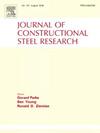机架支撑仓库与减少截面对角线改善耗散地震行为
IF 4
2区 工程技术
Q1 CONSTRUCTION & BUILDING TECHNOLOGY
引用次数: 0
摘要
机架式仓库是目前设计的易受地震作用影响的结构,主要涉及关键部件,容易发生准脆性破坏。本文为这些仓库的横向框架提出了一种专门的设计方法,其主要目标是利用潜在的延性来源(在拉伸力下对角线的屈服),同时保护非耗散组件,并保持这些结构的典型结构配置和技术组件。为此,对角线的截面在特定区域减小,允许屈服和抗震消散,同时确保连接的超强度。还提供了具体的指导方针,设计减少的截面部分,以达到必要的延展性水平,在局部和整体,并限制长细的轮廓。通过设计和数值评估案例研究的地震易损性,并将获得的行为与使用当前方法设计的相同结构的行为进行比较,评估了该方法的潜力。结果表明,新方法可以在高于设计烈度的地震条件下保护对角连接和非耗散单元。减少截面支架的实验活动是一项正在进行的活动,必须评估有效行为,并提供一般设计标准,也考虑到制造和装配过程中产生的几何和材料缺陷。本文章由计算机程序翻译,如有差异,请以英文原文为准。
Rack supported warehouses with reduced-section diagonals for improved dissipative seismic behaviour
Rack supported warehouses are structures proven to be vulnerable to seismic action as currently designed, being prone to quasi-brittle failures that mainly involve key components. This paper presents a dedicated design approach for the transversal frames of these warehouses, with the main objective of exploiting potential sources of ductility (yielding of diagonals under tensile force) while protecting the non-dissipative components and maintaining the structural configuration and technological components typical of these structures. To this end, the diagonal's cross-section is reduced in specific areas, allowing for yielding and seismic dissipation, while ensuring the overstrength of the connection. Specific guidelines are also provided to design the reduced section portions to achieve the necessary ductility level, both locally and globally, and to limit the slenderness of the profile. The potential of the approach is evaluated by designing and numerically assessing the seismic vulnerability of a case study and comparing the obtained behaviour to that of the same structure designed using the current approach. The results show that the new approach allows for the protection of diagonal connections and non-dissipative elements for seismic intensities higher than the design level. An experimental campaign on the reduced-section braces is an ongoing activity necessary to assess the effective behaviour and to provide general design criteria that also account for geometrical and material imperfections arising from fabrication and assembly processes.
求助全文
通过发布文献求助,成功后即可免费获取论文全文。
去求助
来源期刊

Journal of Constructional Steel Research
工程技术-工程:土木
CiteScore
7.90
自引率
19.50%
发文量
550
审稿时长
46 days
期刊介绍:
The Journal of Constructional Steel Research provides an international forum for the presentation and discussion of the latest developments in structural steel research and their applications. It is aimed not only at researchers but also at those likely to be most affected by research results, i.e. designers and fabricators. Original papers of a high standard dealing with all aspects of steel research including theoretical and experimental research on elements, assemblages, connection and material properties are considered for publication.
 求助内容:
求助内容: 应助结果提醒方式:
应助结果提醒方式:


